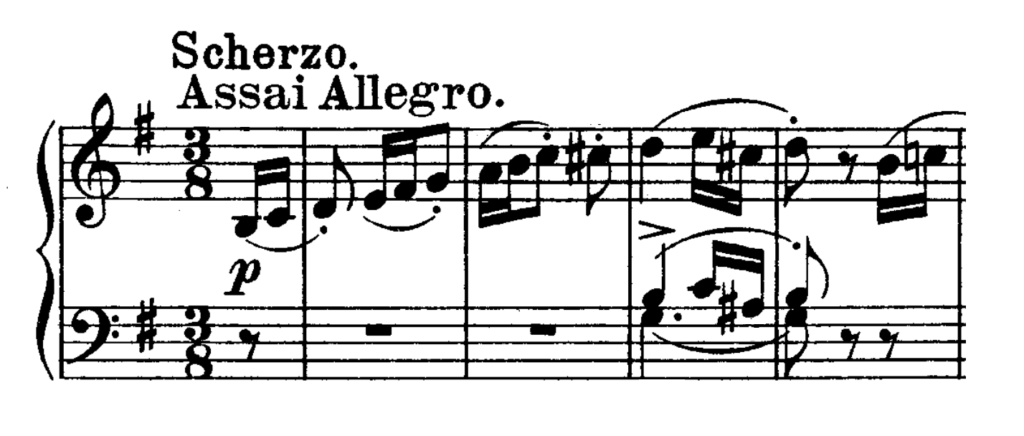Analysis
Contents
For the benefit of all pianists learning this work, we present to you a concise and easy to use analysis of Beethoven’s Piano Sonata No.10 in G major
First Movement (Allegro)
Form: Sonata Form. G major.
EXPOSITION:
Bars 1-9: Subject in G major (tonic). The first subject consists of an eight-bar sentence in tonic key throughout, the first four bars being all in the same rhythm.
Bars 9-26: Connecting Episode. The last six bars of the melodious connecting episode are constructed upon a pedal point of A, reached by a gradually rising bass from G to the ninth above, the melody also being in sequence.
Bars 27-48: Second Subject in D major. The second subject in D major is composed of two sections of four bars each, the first ending on dominant seventh, the second on chord of D major overlapping a new phrase of one bar, which is repeated three times, the third repetition being altered to end in A major; the same phrase recurs again leading to a modulation to G major, followed by a passage leading back to D major.
Bars 26-64: Coda. The Coda is composed of new material of the nature of a supplementary subject.
Double bar and repeat.
DEVELOPMENT:
Bars 65-126: The development, commencing in G minor, refers to both the first and second subjects. It ends on dominant seventh after fourteen bars on dominant pedal point.
RECAPITULATION:
Bars 126-134: First Subject in original key.
Bars 134-154: Connecting Episode. The connecting episode re-appears altered so as the end on the dominant.
Bars 155-176: Second Subject in G major (tonic).
Bars 176-End: Coda. The Coda resembles that in the exposition for several bars, after which a variation of the first subject occurs on tonic pedal point.
Second Movement (Andante)
Form: Air With Variations C major.
AIR:
Bars 1-22: The “Air” is in two-bar rhythm.
FIRST VARIATION:
Bars 23-45: In the first variation there is syncopation in nearly every bar.
SECOND VARIATION:
Bars 45-71: The second variation contains several instances of pedal point.
THIRD VARIATION:
Bars 71-91: The third variation is characterized by a persistent semiquaver (sixteenth note) figure, the harmony being exactly as in the exposition of the air.
CODA:
Bars 91-End: The Coda contains slight reminiscences of the original theme.
Third Movement (Scherzo: Allegro Assai)
Form: Rondo Form. G Major.
FIRST PART:
Bars 1-23: First Subject in G major (tonic). The first subject begins with a sentence of eight bars in G major followed by a section of eight bars built entirely upon the chord of the dominant seventh, the first sentence then re-appears curtailed to six bars.
Bars 24-42: Second Subject in E minor, ending in G major. The second subject is in four-bar rhythm, and is constructed upon Bars 24-27, ending in A minor, Bar 39, followed by a chord of the dominant seventh.
Bars 43-65: First Subject in original key.
Bars 65-74: After the second entry of the first subject there are eight bars of the chord of the dominant seventh (Bars 65-73) preparatory to the entry of the third subject.
SECOND PART:
Bars 74-125: Third Subject in C major. The third subject commences with a sentence of eight bars ending with full close in C major, which is repeated. A passage in four-bar rhythm, principally on dominant pedal point (of C major), closing in G, leads to the re-appearance of the first sentence. The last two bars are repeated twice, forming a little Codetta.
Bars 125-139: The fourteen bars (Bars 125-135) formed upon the first subject ending on the dominant, lead to the third entry of the first subject.
THIRD PART:
Bars 139-161: First Subject in original key.
Bars 161-190: Twenty-nine bars of a fragmentary character, built upon the first subject, occur before the succeeding episode, Bars 161-190.
Bars 190-238: Episode. This episode takes the place of the repetition of the second subject, it begin and ends in G major (tonic), and is based upon Bars 191-192.
Bars 238-End: First Subject (curtailed) in original key. There is a tonic pedal point from Bars 238 to the end.









